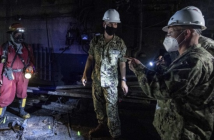Kelvin Hamilton, the chief executive of FlareBright, discusses the company’s innovative SnapShot unmanned air system that is palm-sized, propelled by a slingshot and able to take high resolution images with Defense & Aerospace Report Editor Vago Muradian at the DSEI 2019 conference and tradeshow. Our coverage is sponsored by L3Harris and Leonardo DRS and in partnership with Clarion Events — DSEI’s organizer — and working with the UK Department of International Trade’s Defence & Security Organisation to bring our audience the best in British defense and security.
Vago Muradian: Welcome to the Defense and Aerospace Report. I’m Vago Muradian here at the Excel Center in London where we’re covering this 20th anniversary edition of DSEI, one of the world’s leading defense and security trade shows. Our coverage here is sponsored by L3Harris and Leonardo DRS, and we’re partnered with Clarion Events, the organizers of this great exhibition and many more all around the world. And we’re working together with the UK Department of International Trade, Defence and Security Organization to bring you the very best of British defense and security.
We are at the tail-end of this show, and thankfully Dr. Kelvin Hamilton, the CEO of FlareBright has been kind enough to stay here just a little bit longer.
Kelvin, you have a history of innovation in terms of founding SeaBright. Just a great undersea company and then selling it obviously to Bluefin Technologies and they’re working on a whole new generation of undersea, deep sea systems. And you are the founder of FlareBright, and every once in a while at a trade show you run into somebody and you go holy crap, that’s an amazing idea. Tell us a little bit about what you’ve developed here, because it’s absolutely incredible.
Dr. Kelvin Hamilton: Okay. This is our, it’s called SnapShot. This is our instant imaging drone. The idea is it’s the simplest thing to use. Simplest way to get an aerial image. There’s no radio, no communications, no GPS, no pilot. What you do is you fire it up into the air from any platform. It could be a Crossbow 40 milliliter launcher, we really don’t care. So it goes up 200 meters. It’s a glider. It’s totally silent. All the way up, it’s fighting the wind, trying to fly the path. It goes up to 100 meters apogee, takes the image of the area that you’re interested in, and then it homes back to the user. So that’s the main thing.
So it’s super strong. It just lands at your feet. So ten seconds after you fire it, you have it back in your hand. There’s no batteries. You just plug it into your smart phone or tablet, anything like that. It charges back up in about 20 seconds. You can scroll through the images on your smart phone. Because it has a navigation system you can tap on the image and get the range and bearing to something that you see. Then that’s it. You can just fire it up again. So no training. Super simple. Super strong. You can drop it on the ground. It just bounces back. And you can fire it hundreds and hundreds of times.
Mr. Muradian: And this is, so it can land, it just doesn’t only have to land on grass. It can also land on hard surfaces.
Dr. Hamilton: This is a prototype. Even these, you can throw it on the floor as hard as you want and it will just bounce back up. You can try it, crush it in your hands, it won’t do it. They’re incredibly strong. They’re designed to be strong and tough and for soldiers out in the field.
Mr. Muradian: And it is printed, isn’t it?
Dr. Hamilton: Yes, these prototypes are 3D printed, so we have our own 3D printer. This is a $6,000 version. So we 3D print carbon fiber. We’re still iterating slightly on the air foil shapes and things like that. So every week we’re flight testing and tweaking things.
We’re talking to the National Composite Center in Bristol in the UK to talk about high volume production. 3D printing throws away a lot of the strength of the carbon fighter. So this currently uses something like half mil skin thickness but we can go down to about .1 in production.
Mr. Muradian: And of course that will get you, you can have a little bit more payload on it, or you can get a little more altitude.
Dr. Hamilton: That’s right, yes. So we’re all about keeping the mass down so the energy that you need to launch goes down which means we can use even more launchers. So right now to launch it it’s about the same as a good baseball bat strike on a baseball. So if you can do more than that, you can launch this thing. And it’s only getting smaller. The next plan is to miniaturize this. So this is about a tennis ball size. It will go down to about golf ball size. That’s the plan.
Mr. Muradian: And one of the great things about this is it’s not transmitting. So at the end of the day you shoot it up and it comes back and then you look at it so it can’t be jammed.
Dr. Hamilton: That’s right. That’s a big problem with drones right now. Jamming is becoming more and more ubiquitous. We just don’t use radio at all. So we’ve had drone jamming companies up and go how can we jam your drone? It’s like you cannot. There’s no
Bluetooth, no WiFi, no GPS, nothing. Totally stealthy, jam proof.
Mr. Muradian: And I know this is a sensitive topic, but what’s the rough price point of this, right? Because you can’t look at it as price, right? I mean in the context of a military operation, a photograph like that is priceless when you need to know what’s on the other side of that building. But what’s the rough price point you guys are shooting at to ensure market dominance, Kelvin?
Dr. Hamilton: Well the idea is that we want these absolutely everywhere, so it’s not supposed to be a golden Rolls Royce system. So every platoon, every squad has these things. So we’re looking at about between five and ten thousand dollars for the low volume. That seems to be roughly okay in the military space.
Mr. Muradian: And one last question. So how do you get something so small, right? When you said it’s fighting the wind. Wind at ground level is one thing. Wind at 50 feet is, I mean I think many people don’t recognize that there are actually just 100 feet above you the wind could be moving a lot faster than it’s moving where you are. How does something so small, so light, still have the kind of control to do what it is you want it to do?
Dr. Hamilton: Quad copters stop flying at about 20 knots, roughly. We already test in 20 knots plus gusts, so some of the videos you can see on-line, you’ll see the vehicle really fighting to control. So the way we get away with fighting the wind is first of all it has a super smart software control system, that’s really the main innovation in this where all the work has gone. Secondly, we fire it really fast and it comes down really fast. So a normal airplane is fighting to land and glide, but we just come down like a falcon stooping. So that’s how we work. It’s really small, it’s really dense, it’s really fast, and it’s really smart.
Mr. Muradian: And how many mega pixel on the image? Because you actually get a pretty dense, rich image.
Dr. Hamilton: That’s right. Because it’s a glider there’s no vibration from engines or propellers or anything like that, so the images we get are actually really good.
This version has something like a five mega pixel camera on it because it’s a prototype. But we can use any camera. So it’s really a mobile phone system inside. So whatever the latest mobile phone camera is, we can fit that.
Mr. Muradian: And also with a new generation of miniaturized night vision, you can also equip this to be a night vision or even other payloads, couldn’t you? I mean whether it’s for signals or anything else.
Dr. Hamilton: That’s right. So we have a slightly bigger one, it’s maybe a centimeter bigger, which can take a thermal camera. Very popular, again, with the military. And our test bed that we’ve been flying for the last two years can carry about 250 grams of payload. So for us it’s all the same system. The software’s the same. You have to tune them a little bit for the bigger models, but we can either send this up and it comes back to you; or you can send one with a 250-gram payload out 300 meters to one or two meters accuracy.
Mr. Muradian: That’s utterly fantastic.
So when do you think you’re going to be landing your first customers on this?
Dr. Hamilton: We have a few more months of flight testing on this, tuning. So the software is stable. We have to iterate a little bit with the aerodynamics. So sometime after Christmas we should have some test units, some evaluation units available. We already have several people wanting to do evaluations with it. We’re applying to the Army Warfighting Experiment in March in the UK, and we think about six months after that, after some feedback from customers, we should have an entry level product coming out. So late 2020.
Mr. Muradian: And where can people go for more information?
Dr. Hamilton: You can go to www.FlareBright.com and flare as in a signal flare.
Mr. Muradian: Because you can use a signal flare gun as well.
Dr. Hamilton: That’s right. In fact that was the original idea, was a smart life-saving flare.
Mr. Muradian: That’s fantastic, because I see the guy over there, because at first when we came up here we were like wait a minute, how on earth do you — ah, I get it. You know, we Americans aren’t very sharp.
Dr. Hamilton: [Laughter]. That is not what I’ve found in reality.
Yeah, so we can use flare guns. They’re a little bit small for this version, but future ones we can do that, certainly. Crossbows, CO2 [Parrot], sort of paintball guns, grenade launchers, anything.
Mr. Muradian: That’s fantastic.
Kelvin Hamilton, absolute pleasure meeting you. CEO of FlareBright. Absolutely brilliant idea. I wish you all the best of luck and hopefully we can stay in touch with you and keep updating our audience as you guys move to bigger and better things. Best of luck.
Dr. Hamilton: We’d love to. Thank you very much.
# # # #



